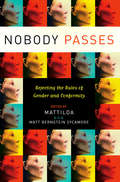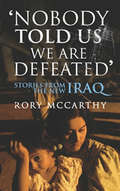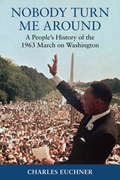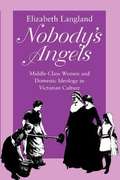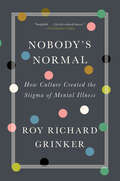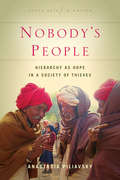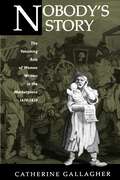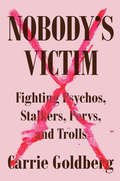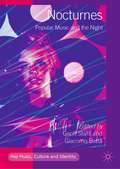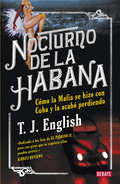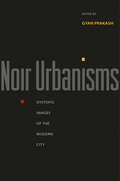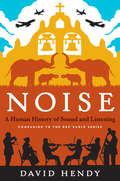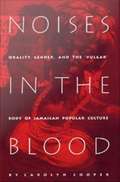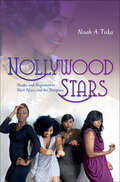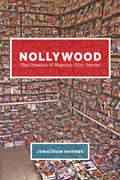- Table View
- List View
Nobody Men: Neutrality, Loyalties, and Family in the American Revolution
by Travis GlassonThe story of colonists who were neither loyalists nor patriots during the American Revolution, told through the experiences of one transatlantic family At least one‑third of the colonial population were neutrals during the American Revolution, yet they have rarely featured in narratives that shape our ideas about the conflict. By following a single transatlantic family, the Crugers, historian Travis Glasson puts neutrals—the &“nobody men&”—at the center of this tumultuous period&’s history. Like most neutrals, the Crugers prioritized peace above any specific constitutional arrangement and sought ways out of the military struggle. The Crugers were prominent among prewar defenders of colonial rights, and their experiences once the shooting started, in places including New York, the island of St. Croix, and London, reveal the complex dilemmas that confronted those in the middle during the violent upheaval. The Crugers&’ dealings with each other—and with a cast of boldfaced names including Alexander Hamilton, John Jay, Edmund Burke, John Wilkes, Lord North, and George Washington—illuminate how some people looked to chart alternate courses through perilous waters. Based on extensive research in the United States and Britain, Nobody Men humanizes what it meant to live through revolutionary civil war and recovers little‑known but essential histories of how new nations formed as an older empire broke apart.
Nobody Passes: Rejecting the Rules of Gender and Conformity
by Matt Bernstein SycamoreNobody Passes is a collection of essays that confronts and challenges the very notion of belonging. By examining the perilous intersections of identity, categorization, and community, contributors challenge societal mores and countercultural norms. Nobody Passes explores and critiques the various systems of power seen (or not seen) in the act of "passing." In a pass-fail situation, standards for acceptance may vary, but somebody always gets trampled on. This anthology seeks to eliminate the pressure to pass and thereby unearth the delicious and devastating opportunities for transformation that might create. Mattilda, aka Matt Bernstein Sycamore, has a history of editing anthologies based on brazen nonconformity and gender defiance. Mattilda sets out to ask the question, "What lies are people forced to tell in order to gain acceptance as 'real'." The answers are as varied as the life experiences of the writers who tackle this urgent and essential topic.
Nobody Told Us We Are Defeated: Stories from the new Iraq
by Rory McCarthyIn May 2003 journalist Rory McCarthy went to Iraq to cover what was claimed to be the triumphant rebuilding of the country after the American invasion. Two years later he left a place teetering on the brink of civil war, whose inhabitants longed for the Americans to leave but feared what would happen if they did. Throughout his stay, McCarthy was struck by how little the Iraqi point of view was represented in the media, drowned out by the message of the British and American occupying powers. This book is an attempt to recify that. By telling the stories of some of the Iraqis that McCarthy came to know, it reveals, more subtly and interestingly than any political rhetoric, the fatal extent to which they were misunderstood. From the survivor of one of Sadaam's mass graves to the insurgents of Najaf, McCarthy shows us men and women living the dilemmas of Iraq from day to day, and making crucial decisions about where they stand. The result is a moving and important book that gives a remarkable overview of a nation in turmoil.
Nobody Turn Me Around
by Charles EuchnerOn August 28, 1963, over a quarter-million people--about two-thirds black and one-third white--held the greatest civil rights demonstration ever. Martin Luther King, Jr. delivered his iconic "I Have a Dream" oration. And just blocks away, President Kennedy and Congress skirmished over landmark civil rights legislation. As Charles Euchner reveals, the importance of the march is more profound and complex than standard treatments of the 1963 March on Washington allow. In this major reinterpretation of the Great Day--the peak of the movement--Euchner brings back the tension and promise of that day. Building on countless interviews, archives, FBI files, and private recordings, Euchner shows freedom fighters as complex, often conflicted, characters. He explores the lives of Philip Randolph and Bayard Rustin, the march organizers who worked tirelessly to make mass demonstrations and nonviolence the cornerstone of the movement. He also reveals the many behind-the-scenes battles--the effort to get women speakers onto the platform, John Lewis's damning speech about the federal government, Malcolm X's biting criticisms and secret vows to help the movement, and the devastating undercurrents involving political powerhouses Kennedy and FBI director J. Edgar Hoover. For the first time, Euchner tells the story behind King's "Dream" images. Euchner's hour-by-hour account offers intimate glimpses of the masses on the National Mall--ordinary people who bore the scars of physical violence and jailings for fighting for basic civil rights. The event took on the call-and-response drama of a Southern church service, as King, Lewis, Mahalia Jackson, Roy Wilkins, and others challenged the throng to destroy Jim Crow once and for all. Nobody Turn Me Around will challenge your understanding of the March on Washington, both in terms of what happened but also regarding what it ultimately set in motion. The result was a day that remains the apex of the civil rights movement--and the beginning of its decline.
Nobody's Angels: Middle-Class Women and Domestic Ideology in Victorian Culture
by Elizabeth LanglandVictoria's accession to the throne in 1837 coincided with the birth of a now notorious gender stereotype-- the Angel in the House. Comparing the position of real women-- from the Queen of England to middle-class housewives-- with their status as household angels, Elizabeth Langland explores a complex image of femininity in Victorian culture. Langland offers provocative readings of nineteenth-century fiction as well as a rare glimpse into etiquette guides, home management manuals, and cookbooks. She traces the implications of a profound contradiction: although the home was popularly depicted as a private moral haven, running the middle-class household-- which included at least one servant-- was in fact an exercise in class management. Drawing on the work of Foucault, Benjamin, and Bourdieu, and of recent feminist theorists, Langland considers novels by Dickens, Gaskell, Oliphant, and Eliot, as well as the memoirs of Hannah Cullwick, a former domestic servant who married a middle-class man. Langland discovers that the middle-class wife assumed a more complex and important function than has ever been recognized. With her substantial power veiled in myth, the Victorian angel mastered skills that enabled her to support a rigid class system; at the same time, however, her achievements unobtrusively set the stage for a feminist revolution. Nobody's Angels reconstructs a disturbing picture of social change that depended as much on protecting class inequity as on promoting gender equality.
Nobody's Law: Legal Consciousness and Legal Alienation in Everyday Life (Palgrave Socio-Legal Studies)
by Marc HertoghNobody’s Law shows how people – who are disappointed, disenchanted, and outraged about the justice system – gradually move away from law. Using detailed case studies and combining different theoretical perspectives, this book explores the legal consciousness of ordinary people, businessmen, and street-level bureaucrats in the Netherlands. The empirical research in this study tells an original and alternative narrative about the role of law in everyday life. While previous studies emphasize the law’s hegemony and argue that it’s ‘all over’, Hertogh shows that legal proliferation makes it harder for people to know, and subsequently identify with, the law. As a result, official law has become increasingly remote and irrelevant to many people. The central finding presented in this highly topical text is that these developments signal a process of ‘legal alienation’— a gradual and mundane process with potentially serious consequences for the legitimacy of law. A timely and original study, this book will be of particular interest to scholars in the fields of law and society, socio-legal studies and legal theory.
Nobody's Normal: How Culture Created The Stigma Of Mental Illness
by Roy Richard GrinkerA compassionate and captivating examination of evolving attitudes toward mental illness throughout history and the fight to end the stigma. For centuries, scientists and society cast moral judgments on anyone deemed mentally ill, confining many to asylums. In Nobody’s Normal, anthropologist Roy Richard Grinker chronicles the progress and setbacks in the struggle against mental-illness stigma—from the eighteenth century, through America’s major wars, and into today’s high-tech economy. Nobody’s Normal argues that stigma is a social process that can be explained through cultural history, a process that began the moment we defined mental illness, that we learn from within our communities, and that we ultimately have the power to change. Though the legacies of shame and secrecy are still with us today, Grinker writes that we are at the cusp of ending the marginalization of the mentally ill. In the twenty-first century, mental illnesses are fast becoming a more accepted and visible part of human diversity. Grinker infuses the book with the personal history of his family’s four generations of involvement in psychiatry, including his grandfather’s analysis with Sigmund Freud, his own daughter’s experience with autism, and culminating in his research on neurodiversity. Drawing on cutting-edge science, historical archives, and cross-cultural research in Africa and Asia, Grinker takes readers on an international journey to discover the origins of, and variances in, our cultural response to neurodiversity. Urgent, eye-opening, and ultimately hopeful, Nobody’s Normal explains how we are transforming mental illness and offers a path to end the shadow of stigma.
Nobody's People: Hierarchy as Hope in a Society of Thieves (South Asia in Motion)
by Anastasia PiliavskyWhat if we could imagine hierarchy not as a social ill, but as a source of social hope? Taking us into a "caste of thieves" in northern India, Nobody's People depicts hierarchy as a normative idiom through which people imagine better lives and pursue social ambitions. Failing to find a place inside hierarchic relations, the book's heroes are "nobody's people": perceived as worthless, disposable and so open to being murdered with no regret or remorse. Following their journey between death and hope, we learn to perceive vertical, non-equal relations as a social good, not only in rural Rajasthan, but also in much of the world—including settings stridently committed to equality. Challenging egalo-normative commitments, Anastasia Piliavsky asks scholars across the disciplines to recognize hierarchy as a major intellectual resource.
Nobody's Story: The Vanishing Acts of Women Writers in the Marketplace, 1670-1920 (The New Historicism: Studies in Cultural Poetics #31)
by Catherine GallagherExploring the careers of five influential women writers of the Restoration and eighteenth century, Catherine Gallagher reveals the connections between the increasing prestige of female authorship, the economy of credit and debt, and the rise of the novel. The "nobodies" of her title are not ignored, silenced, or anonymous women. Instead, they are literal nobodies: the abstractions of authorial personae, printed books, intellectual property rights, literary reputations, debts and obligations, and fictional characters. These are the exchangeable tokens of modern authorship that lent new cultural power to the increasing number of women writers through the eighteenth century. Women writers, Gallagher discovers, invented and popularized numerous ingenious similarities between their gender and their occupation. The terms "woman," "author," "marketplace," and "fiction" come to define each other reciprocally.Gallagher analyzes the provocative plays of Aphra Behn, the scandalous court chronicles of Delarivier Manley, the properly fictional nobodies of Charlotte Lennox and Frances Burney, and finally Maria Edgeworth's attempts in the late eighteenth century to reform the unruly genre of the novel.
Nobody's Victim: Fighting Psychos, Stalkers, Pervs, and Trolls
by Carrie GoldbergNobody's Victim is an unflinching look at a hidden world most people don’t know exists—one of stalking, blackmail, and sexual violence, online and off—and the incredible story of how one lawyer, determined to fight back, turned her own hell into a revolution. “We are all a moment away from having our life overtaken by somebody hell-bent on our destruction.” That grim reality—gleaned from personal experience and twenty years of trauma work—is a fundamental principle of Carrie Goldberg’s cutting-edge victims’ rights law firm. Riveting and an essential timely conversation-starter, Nobody's Victim invites readers to join Carrie on the front lines of the war against sexual violence and privacy violations as she fights for revenge porn and sextortion laws, uncovers major Title IX violations, and sues the hell out of tech companies, schools, and powerful sexual predators. Her battleground is the courtroom; her crusade is to transform clients from victims into warriors. In gripping detail, Carrie shares the diabolical ways her clients are attacked and how she, through her unique combination of advocacy, badass relentlessness, risk-taking, and client-empowerment, pursues justice for them all. There are stories about a woman whose ex-boyfriend made fake bomb threats in her name and caused a national panic; a fifteen-year-old girl who was sexually assaulted on school grounds and then suspended when she reported the attack; and a man whose ex-boyfriend used a dating app to send more than 1,200 men to ex's home and work for sex. With breathtaking honesty, Carrie also shares her own shattering story about why she began her work and the uphill battle of building a business. While her clients are a diverse group—from every gender, sexual orientation, age, class, race, religion, occupation, and background—the offenders are not. They are highly predictable. In this book, Carrie offers a taxonomy of the four types of offenders she encounters most often at her firm: assholes, psychos, pervs, and trolls. “If we recognize the patterns of these perpetrators,” she explains, “we know how to fight back.” Deeply personal yet achingly universal, Nobody's Victim is a bold and much-needed analysis of victim protection in the era of the Internet. This book is an urgent warning of a coming crisis, a predictor of imminent danger, and a weapon to take back control and protect ourselves—both online and off.
Nobody: Casualties of America's War on the Vulnerable, from Ferguson to Flint and Beyond
by Todd Brewster Marc Lamont Hill"An impassioned analysis of headline-making cases....Timely, controversial, and bound to stir already heated discussion." --Kirkus Reviews "A thought-provoking and important analysis of oppression, recommended for those seeking clarity on current events." --Library Journal Unarmed citizens shot by police. Drinking water turned to poison. Mass incarcerations. We've heard the individual stories. Now a leading public intellectual and acclaimed journalist offers a powerful, paradigm-shifting analysis of America's current state of emergency, finding in these events a larger and more troubling truth about race, class, and what it means to be "Nobody."Protests in Ferguson, Missouri and across the United States following the death of Michael Brown revealed something far deeper than a passionate display of age-old racial frustrations. They unveiled a public chasm that has been growing for years, as America has consistently and intentionally denied significant segments of its population access to full freedom and prosperity. In Nobody, scholar and journalist Marc Lamont Hill presents a powerful and thought-provoking analysis of race and class by examining a growing crisis in America: the existence of a group of citizens who are made vulnerable, exploitable and disposable through the machinery of unregulated capitalism, public policy, and social practice. These are the people considered "Nobody" in contemporary America. Through on-the-ground reporting and careful research, Hill shows how this Nobody class has emerged over time and how forces in America have worked to preserve and exploit it in ways that are both humiliating and harmful. To make his case, Hill carefully reconsiders the details of tragic events like the deaths of Michael Brown, Sandra Bland, and Freddie Gray, and the water crisis in Flint, Michigan. He delves deeply into a host of alarming trends including mass incarceration, overly aggressive policing, broken court systems, shrinking job markets, and the privatization of public resources, showing time and time again the ways the current system is designed to worsen the plight of the vulnerable. Timely and eloquent, Nobody is a keen observation of the challenges and contradictions of American democracy, a must-read for anyone wanting to better understand the race and class issues that continue to leave their mark on our country today.
Noch Zukunft haben: Zum Werk Karoline von Günderrodes (Neue Romantikforschung #5)
by Frederike Middelhoff Martina WernliDie literatur- und kulturwissenschaftliche Forschung zu Karoline von Günderrode (1780–1806) setzt seit gut zwei Jahrzehnten neue Akzente. Das Werk der Autorin wird in diesem Zuge als singulärer Beitrag zur Literatur-, Kultur- und Geistesgeschichte der Romantik profiliert, während der ‚Mythos Günderrode‘, der sich auf Leben, Lieben und vor allem Ableben der Autorin konzentriert, fundamental hinterfragt wird. Der vorliegende Band schließt an diese Re-Lektüren und neuen Perspektiven an. Er präsentiert wichtige Untersuchungen zu bislang wenig beleuchteten Facetten von Günderrodes Texten, die u.a. Poetologie, Ästhetik sowie ideengeschichtliche oder politische Aspekte umfassen, und legt zudem eine kommentierte Auswahl bislang kaum bekannter Briefe der Autorin in Transkription und Abbildung vor.
Noch mehr Sand im Getriebe?: Kommunikations- und Interaktionsprozesse zwischen Landes- und Regionalplanung, Politik und Unternehmen der Gesteinsindustrie (RaumFragen: Stadt – Region – Landschaft)
by Olaf Kühne Corinna Jenal Karsten Berr Lara KoegstObwohl mineralische Rohstoffe wie beispielsweise Kies, Sand, Quarz und Naturstein auf vielfältige Weise Grundlagen menschlicher Existenz ermöglichen und garantieren, haben Vorhaben zur Gewinnung mineralischer Rohstoffe vielerorts mit unterschiedlichen Akzeptanzproblemen zu kämpfen. Der planerische Umgang mit Rohstoffsicherung und Rohstoffgewinnung wurde wissenschaftlich bislang hauptsächlich in Bezug auf ökologische oder fachplanerische Problemstellungen, weniger hingegen als teilsystemischer Aspekt in einem soziopolitischen Kontext betrachtet, der durch verstärkten Bürgerprotest und erneuerte Partizipations- und Demokratisierungsbestrebungen gekennzeichnet ist.
Nocturnes: Popular Music and the Night (Pop Music, Culture and Identity)
by Geoff Stahl Giacomo BottàThe night and popular music have long served to energise one another, such that they appear inextricably bound together as trope and topos. This history of reciprocity has produced a range of resonant and compelling imaginaries, conjured up through countless songs and spaces dedicated to musical life after dark. Nocturnes: Popular Music and the Night is one of the first volumes to examine the relationship between night and popular music. Its scope is interdisciplinary and geographically diverse. The contributors gathered here explore how the problems, promises, and paradoxes of the night and music play off of one another to produce spaces of solace and sanctuary as well as underpinning strategies designed to police, surveil and control movements and bodies. This edited collection is a welcome addition to debates and discussions about the cultures of the night and how popular music plays a continuing role in shaping them.
Nocturno de La Habana: Como la mafia se hizo con Cuba y la acabó perdiendo (Vintage Espanol Ser.)
by T.J. EnglishEl primer libro que analiza en profundidad el fenómeno de la mafia en Cuba. En Nocturno de La Habana, T.J. English nos ofrece un relato fascinante sobre el crimen organizado, la corrupción política, la bulliciosa vida nocturna, la revolución y el conflicto internacional en que se entretejen las historias de la mafia y la revolución cubana que terminará con ella. En la década de los cincuenta, mientras el pueblo cubano se encuentra sometido a un régimen represivo y violento, los jefes mafiosos Meyer Lansky y Lucky Luciano fijaron sus ojos en Cuba. Para ellos era un sueño dorado, la última esperanza para la mafia tras la bonanza de la Ley Seca. Lansky, el mafioso judío, ganó la partida y se hizo con el control de la isla tras haber cultivado estrechos lazos con el dictador Fulgencio Batista. En poco tiempo y con el corrupto gobierno en el bolsillo, Lansky y sus hombres se hicieron con los mayores hoteles y casinos de la ciudad, convirtiéndola en un centro de turismo sin precedentes: las fiestas más lujosas, los famosos de más relumbrón, las mujeres más hermosas, juegos de azar y apuestas sin límite. Pero no contaban con la llegada de Fidel Castro y Ernesto Guevara, empeñados en derrocar al gobierno corrupto y sus aliados extranjeros en una épica batalla que English capta en toda su belleza, gloria y decadencia. Reseñas:«Por fin, el libro definitivo sobre los años dorados de la Mafia en Cuba.»Sam Giancana «Dedicado a los fans de El Padrino II, pero con giros que ni siquiera ellos pueden prever.»Kirkus Reviews
Noir Urbanisms: Dystopic Images of the Modern City
by Gyan PrakashDystopic imagery has figured prominently in modern depictions of the urban landscape. The city is often portrayed as a terrifying world of darkness, crisis, and catastrophe. Noir Urbanisms traces the history of the modern city through its critical representations in art, cinema, print journalism, literature, sociology, and architecture. It focuses on visual forms of dystopic representation--because the history of the modern city is inseparable from the production and circulation of images--and examines their strengths and limits as urban criticism. Contributors explore dystopic images of the modern city in Germany, Mexico, Japan, India, South Africa, China, and the United States. Their topics include Weimar representations of urban dystopia in Fritz Lang's 1927 film Metropolis; 1960s modernist architecture in Mexico City; Hollywood film noir of the 1940s and 1950s; the recurring fictional destruction of Tokyo in postwar Japan's sci-fi doom culture; the urban fringe in Bombay cinema; fictional explorations of urban dystopia in postapartheid Johannesburg; and Delhi's out-of-control and media-saturated urbanism in the 1980s and 1990s. What emerges in Noir Urbanisms is the unsettling and disorienting alchemy between dark representations and the modern urban experience. In addition to the editor, the contributors are David R. Ambaras, James Donald, Rubén Gallo, Anton Kaes, Ranjani Mazumdar, Jennifer Robinson, Mark Shiel, Ravi Sundaram, William M. Tsutsui, and Li Zhang.
Noise
by David HendyWhat if history had a sound track? What would it tell us about ourselves? Based on a thirty-part BBC Radio series and podcast, Noise explores the human dramas that have revolved around sound at various points in the last 100,000 years, allowing us to think in fresh ways about the meaning of our collective past. Though we might see ourselves inhabiting a visual world, our lives have always been hugely influenced by our need to hear and be heard. To tell the story of sound—music and speech, but also echoes, chanting, drumbeats, bells, thunder, gunfire, the noise of crowds, the rumbles of the human body, laughter, silence, conversations, mechanical sounds, noisy neighbors, musical recordings, and radio—is to explain how we learned to overcome our fears about the natural world, perhaps even to control it; how we learned to communicate with, understand, and live alongside our fellow beings; how we've fought with one another for dominance; how we've sought to find privacy in an increasingly noisy world; and how we've struggled with our emotions and our sanity. Oratory in ancient Rome was important not just for the words spoken but for the sounds made—the tone, the cadence, the pitch of the voice—how that voice might have been transformed by the environment in which it was heard and how the audience might have responded to it. For the Native American tribes first encountering the European colonists, to lose one's voice was to lose oneself. In order to dominate the Native Americans, European colonists went to great effort to silence them, to replace their "demonic" "roars" with the more familiar "bugles, speaking trumpets, and gongs. " Breaking up the history of sound into prehistoric noise, the age of oratory, the sounds of religion, the sounds of power and revolt, the rise of machines, and what he calls our "amplified age," Hendy teases out continuities and breaches in our long relationship with sound in order to bring new meaning to the human story.
Noise Channels: Glitch and Error in Digital Culture (Electronic Mediations)
by Peter KrappTo err is human; to err in digital culture is design. In the glitches, inefficiencies, and errors that ergonomics and usability engineering strive to surmount, Peter Krapp identifies creative reservoirs of computer-mediated interaction. Throughout new media cultures, he traces a resistance to the heritage of motion studies, ergonomics, and efficiency; in doing so, he shows how creativity is stirred within the networks of digital culture. Noise Channels offers a fresh look at hypertext and tactical media, tunes into laptop music, and situates the emergent forms of computer gaming and machinima in media history. Krapp analyzes text, image, sound, virtual spaces, and gestures in noisy channels of computer-mediated communication that seek to embrace—rather than overcome—the limitations and misfires of computing. Equally at home with online literature, the visual tactics of hacktivism, the recuperation of glitches in sound art, electronica, and videogames, or machinima as an emerging media practice, he explores distinctions between noise and information, and how games pivot on errors at the human–computer interface. Grounding the digital humanities in the conditions of possibility of computing culture, Krapp puts forth his insight on the critical role of information in the creative process.
Noise as a Constructive Element in Music: Theoretical and Music-Analytical Perspectives (Musical Cultures of the Twentieth Century)
by Mark DelaereMusic and noise seem to be mutually exclusive. Music is generally considered as an ordered arrangement of sounds pleasing to the ear and noise as its opposite: chaotic, ugly, aggressive, sometimes even deafening. When presented in a musical context, noise can thus act as a tool to express resistance to predominant cultural values, to society or to socioeconomic structures (including those of the music industry). The oppositional stance confirms current notions of noise as something which is destructive, a belief not only cherished by hard-core rock bands but also shared by engineers and companies developing devices to suppress or reduce noise in our daily environment. In contrast to the common opinions on noise just described, this volume seeks to explore the constructive potential of noise in contemporary musical practices. Rather than viewing noise as a ‘defect’, this volume aims at studying its aesthetic and cultural potential. Within the noise music study field, most recent publications focus on subgenres such as psychedelic post-rock, industrial, hard-core punk, trash or rave, as they developed from rock and popular music. This book includes work on avant-garde music developed in the domain of classical music as well. In addition to already well-established (social) historical and aesthetical perspectives on noise and noise music, this volume offers contributions by music analysts.
Noise as a Constructive Element in Music: Theoretical and Music-Analytical Perspectives (Musical Cultures of the Twentieth Century)
by Mark DelaereMusic and noise seem to be mutually exclusive. Music is generally considered as an ordered arrangement of sounds pleasing to the ear and noise as its opposite: chaotic, ugly, aggressive, sometimes even deafening. When presented in a musical context, noise can thus act as a tool to express resistance to predominant cultural values, to society or to socioeconomic structures (including those of the music industry). The oppositional stance confirms current notions of noise as something which is destructive, a belief not only cherished by hard-core rock bands but also shared by engineers and companies developing devices to suppress or reduce noise in our daily environment.In contrast to the common opinions on noise just described, this volume seeks to explore the constructive potential of noise in contemporary musical practices. Rather than viewing noise as a ‘defect’, this volume aims at studying its aesthetic and cultural potential.Within the noise music study field, most recent publications focus on subgenres such as psychedelic post-rock, industrial, hard-core punk, trash or rave, as they developed from rock and popular music. This book includes work on avant-garde music developed in the domain of classical music as well. In addition to already well-established (social) historical and aesthetical perspectives on noise and noise music, this volume offers contributions by music analysts.
Noises in the Blood
by Carolyn CooperThe language of Jamaican popular culture--its folklore, idioms, music, poetry, song--even when written is based on a tradition of sound, an orality that has often been denigrated as not worthy of serious study. In Noises in the Blood, Carolyn Cooper critically examines the dismissed discourse of Jamaica's vibrant popular culture and reclaims these cultural forms, both oral and textual, from an undeserved neglect. Cooper's exploration of Jamaican popular culture covers a wide range of topics, including Bob Marley's lyrics, the performance poetry of Louise Bennett, Mikey Smith, and Jean Binta Breeze, Michael Thelwell's novelization of The Harder They Come, the Sistren Theater Collective's Lionheart Gal, and the vitality of the Jamaican DJ culture. Her analysis of this cultural "noise" conveys the powerful and evocative content of these writers and performers and emphasizes their contribution to an undervalued Caribbean identity. Making the connection between this orality, the feminized Jamaican "mother tongue," and the characterization of this culture as low or coarse or vulgar, she incorporates issues of gender into her postcolonial perspective. Cooper powerfully argues that these contemporary vernacular forms must be recognized as genuine expressions of Jamaican culture and as expressions of resistance to marginalization, racism, and sexism. With its focus on the continuum of oral/textual performance in Jamaican culture, Noises in the Blood, vividly and stylishly written, offers a distinctive approach to Caribbean cultural studies.
Nollywood Stars: Media And Migration In West Africa And The Diaspora (New Directions In National Cinemas Ser.)
by Noah A. TsikaIn this comprehensive study of Nollywood stardom around the world, Noah A. Tsika explores how the industry's top on-screen talents have helped Nollywood to expand beyond West Africa and into the diaspora to become one of the globe's most prolific and diverse media producers. Carrying VHS tapes and DVDs onto airplanes and publicizing new methods of film distribution, the stars are active agents in the global circulation of Nollywood film. From Omotola Jalade-Ekeinde's cameo role on VH1's popular series Hit the Floor to Oge Okoye's startling impersonation of Lady Gaga, this book follows Nollywood stars from Lagos to London, Ouagadougou, Cannes, Paris, Porto-Novo, Sekondi-Takoradi, Dakar, Accra, Atlanta, Houston, New York, and Los Angeles. Tsika tracks their efforts to integrate into various entertainment cultures, but never to the point of effacing their African roots.
Nollywood in Glocal Perspective
by Bala A. MusaThis book gives a panoramic view of the rise and growth of Nollywood, Nigeria’s movie and home video entertainment industry, into the second largest and most prolific movie-producing industry in the world. It offers an analysis of Nollywood’s influence as a local and global cultural force. Scholars from Africa, the African Diaspora and beyond examine the factors that have shaped Nollywood’s unique story-telling, production, and distribution system. The volume shows how internal and external economic, social, cultural and technological changes intersect to define Nollywood’s film-making and entertainment ethos. It is grounded in sound theoretical perspectives that help readers understand the texts and subtexts of the industry’s emergence, transformation, and impact. The range of subjects covered span Nollywood’s historical roots in Nigeria pre-colonial traveling/community theatre to colonial era film-making, and its contemporary spin-offs and inspired cousins across Africa and in Europe. It illuminates the interface of artistic, business, cultural and technological innovation and creativity at the heart of Africa’s local and global pop culture explosion.
Nollywood: The Creation of Nigerian Film Genres
by Jonathan HaynesNigeria's Nollywood has rapidly grown into one of the world's largest film industries, radically altering media environments across Africa and in the diaspora; it has also become one of African culture's most powerful and consequential expressions, powerfully shaping how Africans see themselves and are seen by others. With this book, Jonathan Haynes provides an accessible and authoritative introduction to this vast industry and its film culture. Haynes describes the major Nigerian film genres and how they relate to Nigerian society--its values, desires, anxieties, and social tensions--as the country and its movies have developed together over the turbulent past two decades. As he shows, Nollywood is a form of popular culture; it produces a flood of stories, repeating the ones that mean the most to its broad audience. He interprets these generic stories and the cast of mythic figures within them: the long-suffering wives, the business tricksters, the Bible-wielding pastors, the kings in their traditional regalia, the glamorous young professionals, the emigrants stranded in New York or London, and all the rest. Based on more than twenty years of research, Haynes's survey of Nollywood's history and genres is unprecedented in scope, while his book also vividly describes landmark films, leading directors, and the complex character of this major branch of world cinema.
Nollywood: The Creation of Nigerian Film Genres
by Jonathan HaynesNigeria's Nollywood has rapidly grown into one of the world's largest film industries, radically altering media environments across Africa and in the diaspora; it has also become one of African culture's most powerful and consequential expressions, powerfully shaping how Africans see themselves and are seen by others. With this book, Jonathan Haynes provides an accessible and authoritative introduction to this vast industry and its film culture. Haynes describes the major Nigerian film genres and how they relate to Nigerian society--its values, desires, anxieties, and social tensions--as the country and its movies have developed together over the turbulent past two decades. As he shows, Nollywood is a form of popular culture; it produces a flood of stories, repeating the ones that mean the most to its broad audience. He interprets these generic stories and the cast of mythic figures within them: the long-suffering wives, the business tricksters, the Bible-wielding pastors, the kings in their traditional regalia, the glamorous young professionals, the emigrants stranded in New York or London, and all the rest. Based on more than twenty years of research, Haynes's survey of Nollywood's history and genres is unprecedented in scope, while his book also vividly describes landmark films, leading directors, and the complex character of this major branch of world cinema.

